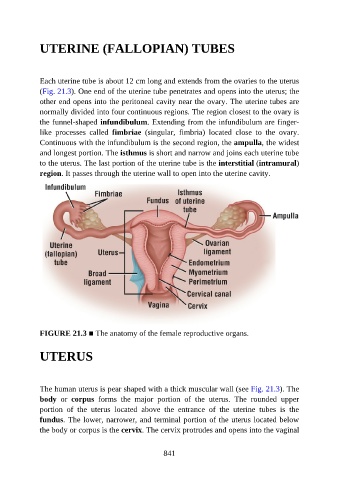Page 842 - Atlas of Histology with Functional Correlations
P. 842
UTERINE (FALLOPIAN) TUBES
Each uterine tube is about 12 cm long and extends from the ovaries to the uterus
(Fig. 21.3). One end of the uterine tube penetrates and opens into the uterus; the
other end opens into the peritoneal cavity near the ovary. The uterine tubes are
normally divided into four continuous regions. The region closest to the ovary is
the funnel-shaped infundibulum. Extending from the infundibulum are finger-
like processes called fimbriae (singular, fimbria) located close to the ovary.
Continuous with the infundibulum is the second region, the ampulla, the widest
and longest portion. The isthmus is short and narrow and joins each uterine tube
to the uterus. The last portion of the uterine tube is the interstitial (intramural)
region. It passes through the uterine wall to open into the uterine cavity.
FIGURE 21.3 ■ The anatomy of the female reproductive organs.
UTERUS
The human uterus is pear shaped with a thick muscular wall (see Fig. 21.3). The
body or corpus forms the major portion of the uterus. The rounded upper
portion of the uterus located above the entrance of the uterine tubes is the
fundus. The lower, narrower, and terminal portion of the uterus located below
the body or corpus is the cervix. The cervix protrudes and opens into the vaginal
841

